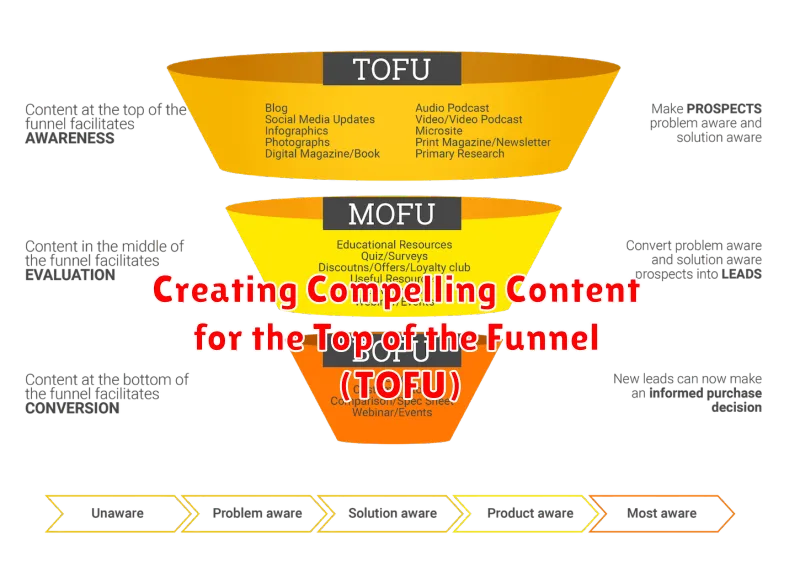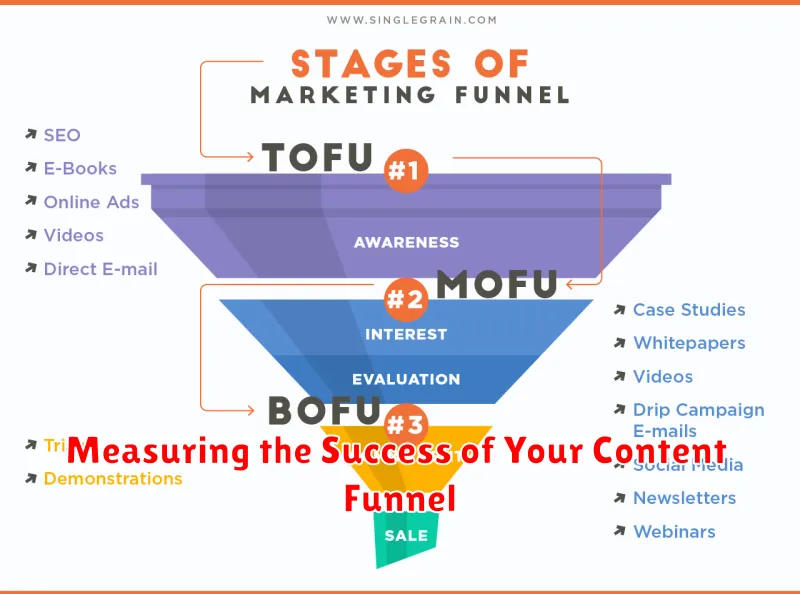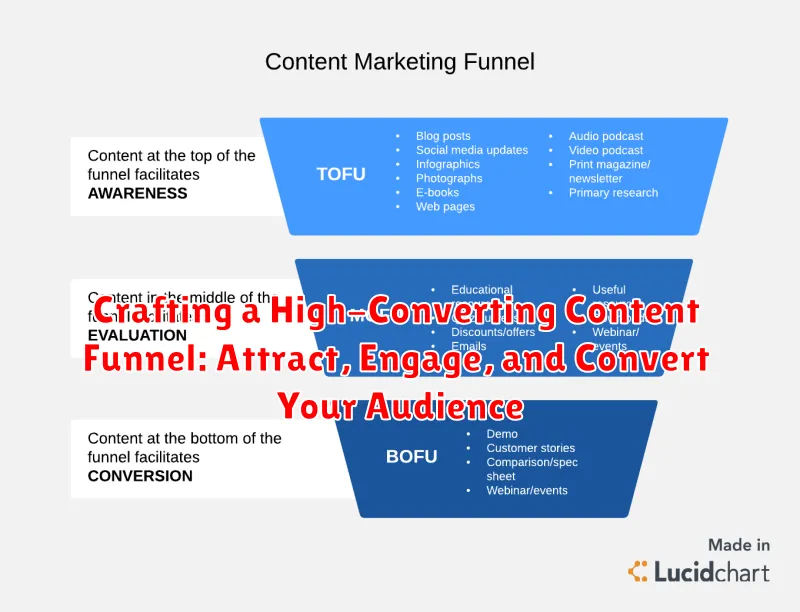In today’s digital landscape, a high-converting content funnel is essential for any business seeking sustainable growth. This strategic approach to content creation goes beyond simply attracting visitors; it focuses on nurturing them through a structured journey, ultimately converting them into loyal customers. This article will delve into the crucial steps involved in crafting a high-converting content funnel, guiding you through the process of attracting, engaging, and converting your target audience. Learn how to strategically leverage content to maximize your conversion rates and achieve tangible business results.
From attracting prospects with compelling top-of-funnel content to engaging them with valuable middle-of-funnel resources and finally converting them with persuasive bottom-of-funnel offers, this comprehensive guide will equip you with the knowledge and tools needed to build a high-performing content funnel. We will explore various content formats, optimization strategies, and analytical techniques that will empower you to create a seamless and effective user experience, ultimately driving conversions and fueling business success. Discover how to transform your content into a powerful engine for growth by creating a high-converting content funnel tailored to your specific business needs.
Understanding the Content Funnel
A content funnel is a strategic marketing model that visualizes the customer journey from initial awareness to final conversion. It’s a structured approach to content creation and distribution, designed to guide potential customers through different stages of engagement.
The funnel metaphor illustrates how a large audience initially interacts with your brand at the top, and then progressively narrows as individuals move through the stages, eventually leading to a smaller group of qualified leads and ultimately, paying customers.
By understanding the content funnel, businesses can effectively tailor their content to meet the specific needs and interests of their target audience at each stage. This targeted approach increases the likelihood of converting prospects into loyal customers.
The content funnel focuses on providing valuable and relevant content that resonates with the audience, building trust, and ultimately driving profitable customer action.
Stages of the Content Funnel
The content funnel typically consists of three key stages: Awareness, Consideration, and Decision. Each stage represents a different point in the customer journey and requires distinct content strategies.
At the Awareness stage, potential customers are just discovering their problem or need. They’re seeking information and education.
In the Consideration stage, prospects have identified their problem and are exploring potential solutions. They’re comparing options and gathering more detailed information.
Finally, the Decision stage involves customers making a purchase choice. They’re ready to commit to a solution and need that final nudge to convert.
Mapping Content to Each Stage of the Funnel
Effectively mapping content to each stage of the funnel ensures a seamless transition for your audience, guiding them towards conversion. This involves understanding the user’s needs and intent at each point.
At the awareness stage, content should focus on addressing broader industry questions and pain points. The goal is to attract a wide audience and position your brand as a valuable resource.
As users move into the consideration stage, content should become more specific, offering solutions and demonstrating expertise. This is the time to showcase your unique value proposition.
Finally, at the decision stage, content should directly address the product or service, focusing on benefits and encouraging conversions. This includes testimonials, case studies, and clear calls to action.
Creating Compelling Content for the Top of the Funnel (TOFU)

The top of the funnel is where you cast a wide net to attract a large audience. Your goal is to capture the attention of potential customers who are just beginning to research solutions to their problems. Content at this stage should be educational, informative, and engaging, not sales-y.
Focus on building brand awareness and establishing yourself as a trusted resource. Think about the questions your target audience is asking at this early stage. What are their pain points? What information are they seeking?
Examples of TOFU Content:
- Blog posts addressing common industry questions
- Infographics presenting interesting data
- Short videos explaining basic concepts
- Social media posts offering helpful tips
- Checklists or worksheets related to their needs
By providing valuable content that addresses their initial needs, you build trust and position yourself as an authority in your field. This encourages them to move further down the funnel.
Engaging Content for the Middle of the Funnel (MOFU)
The middle of the funnel (MOFU) is where you nurture leads who have shown interest and are considering your offerings. MOFU content aims to build trust, address concerns, and position your solution as the best fit. It’s about providing valuable information that helps prospects make informed decisions.
Content at this stage should be more product- or service-specific than TOFU content. Think case studies, webinars, in-depth blog posts, and detailed product comparisons.
Examples of MOFU Content:
- Case studies: Demonstrate the value and effectiveness of your solution by showcasing real-world results.
- Webinars and online events: Offer expert insights and provide a platform for engaging with potential customers.
- Product demos and tutorials: Show how your product or service works and highlight its key features and benefits.
- Comparison guides: Help prospects understand how your offering compares to competitors and why it’s the better choice.
By providing targeted and valuable content at the MOFU stage, you can move leads closer to a purchasing decision and solidify their trust in your brand.
Converting Content for the Bottom of the Funnel (BOFU)
At the bottom of the funnel (BOFU), your audience is ready to convert. They understand their problem, have researched solutions, and are now evaluating specific offerings. BOFU content focuses on persuading prospects to choose your product or service.
This stage requires content that directly addresses purchasing concerns and facilitates the final decision. Examples include:
- Case Studies: Demonstrate the value and effectiveness of your solution with real-world examples.
- Testimonials: Build trust and credibility by showcasing positive experiences from existing customers.
- Free Trials or Demos: Allow potential customers to experience your product or service firsthand.
- Comparison Charts: Clearly outline the advantages of your offering compared to competitors.
- Pricing Pages: Provide transparent and detailed pricing information.
BOFU content should be highly specific, addressing the needs and concerns of prospects actively considering a purchase. The goal is to remove any remaining obstacles and guide them toward conversion.
Measuring the Success of Your Content Funnel

Measuring the effectiveness of your content funnel is crucial for continuous improvement and achieving your marketing goals. Key Performance Indicators (KPIs) provide quantifiable metrics to track progress and identify areas for optimization.
Common KPIs for content funnel measurement include:
- Website traffic: Monitor the volume of visitors entering your funnel at the top.
- Conversion rates: Track the percentage of visitors who move from one stage of the funnel to the next. For example, measure the rate at which leads become customers.
- Engagement metrics: Analyze user behavior within the funnel, including time spent on page, bounce rate, and social shares.
- Lead generation: Measure the number of qualified leads captured through forms, subscriptions, or other lead magnets.
- Sales revenue: Ultimately, track the impact of your content funnel on bottom-line revenue generation.
By consistently monitoring these KPIs, you can gain valuable insights into the performance of your content funnel and make data-driven adjustments to maximize its impact.
Optimizing Your Content Funnel for Conversions
A static content funnel is rarely effective. Continuous optimization is key to maximizing its conversion potential. Regularly analyze key metrics to identify areas for improvement. This involves monitoring metrics like bounce rates, time on page, and conversion rates at each stage.
A/B testing is a powerful technique for optimizing your funnel. Experiment with different headlines, calls to action, and content formats to see what resonates best with your audience. For example, you might test two different landing page headlines to determine which drives more conversions.
Don’t neglect the importance of user experience. A seamless and intuitive user journey through the funnel is essential. Ensure your website is easy to navigate and that content is accessible across devices. A clunky interface can deter potential customers and hinder conversions.
Finally, stay agile and adapt your strategy based on performance data. The digital landscape is constantly evolving, so regularly refining your content funnel is crucial for sustained success.
Tools and Resources for Content Funnel Creation
Several tools and resources can assist in building and managing a successful content funnel. Utilizing these can streamline your content creation process and improve overall conversion rates.
Content Management Systems (CMS)
A robust CMS is essential for organizing and publishing your content. Content management systems provide the framework for creating, scheduling, and managing all your content pieces, ensuring a smooth workflow. Look for features that support content revisions, SEO optimization, and user experience enhancements.
Analytics Platforms
Analytics platforms like Google Analytics are crucial for measuring the performance of your content funnel. They offer valuable insights into user behavior, traffic sources, and conversion rates. Analyzing this data can inform adjustments to your content strategy for maximizing effectiveness.
Keyword Research Tools
Keyword research tools assist in identifying the terms your target audience uses when searching online. This information is vital for creating content that resonates with their needs and searches, drawing them into your funnel. By understanding search intent, you can craft more relevant and engaging content.
Social Media Management Tools
Sharing your content across social media platforms is essential for expanding reach and driving traffic to your funnel. Social media management tools help streamline this process, allowing for efficient scheduling and analysis of your social media activities.

